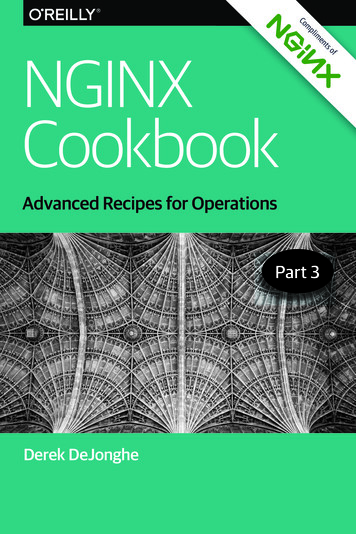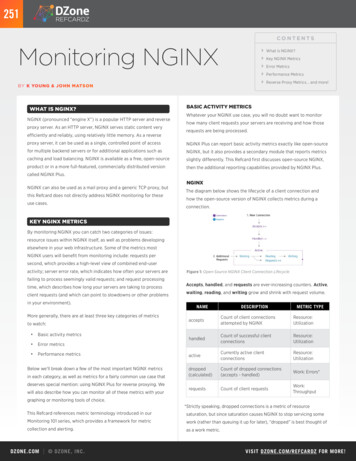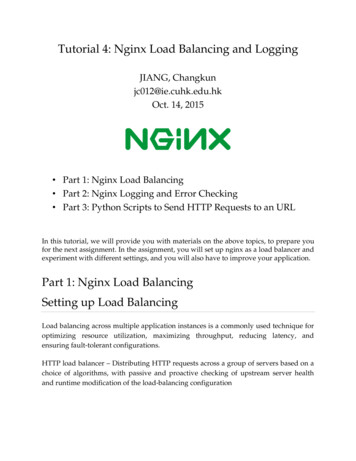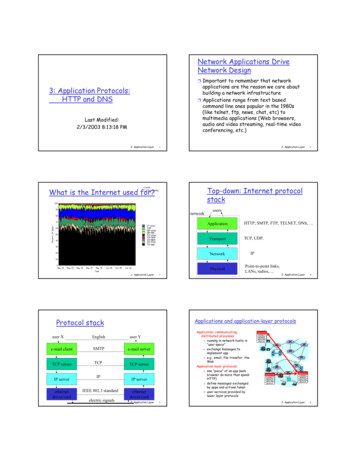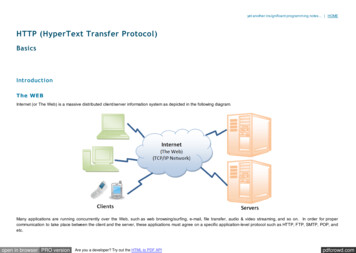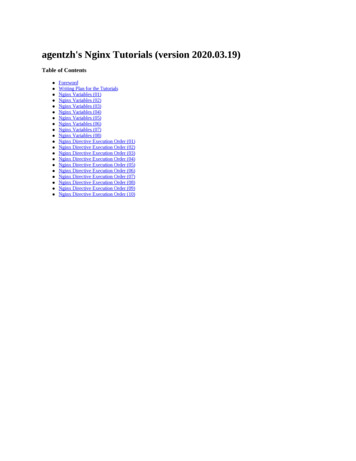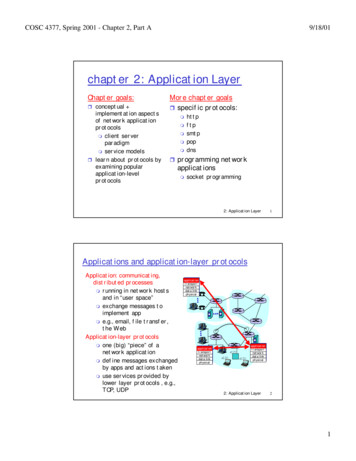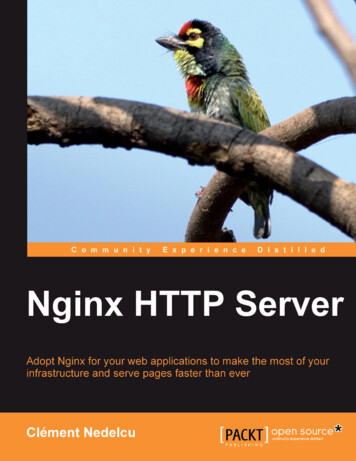
Transcription
Nginx HTTP ServerAdopt Nginx for your web applications to make the mostof your infrastructure and serve pages faster than everClément NedelcuBIRMINGHAM - MUMBAI
Nginx HTTP ServerCopyright 2010 Packt PublishingAll rights reserved. No part of this book may be reproduced, stored in a retrievalsystem, or transmitted in any form or by any means, without the prior writtenpermission of the publisher, except in the case of brief quotations embedded incritical articles or reviews.Every effort has been made in the preparation of this book to ensure the accuracyof the information presented. However, the information contained in this book issold without warranty, either express or implied. Neither the author, nor PacktPublishing, and its dealers and distributors will be held liable for any damagescaused or alleged to be caused directly or indirectly by this book.Packt Publishing has endeavored to provide trademark information about all of thecompanies and products mentioned in this book by the appropriate use of capitals.However, Packt Publishing cannot guarantee the accuracy of this information.First published: July 2010Production Reference: 1140710Published by Packt Publishing Ltd.32 Lincoln RoadOltonBirmingham, B27 6PA, UK.ISBN 978-1-849510-86-8www.packtpub.comCover Image by Vinayak Chittar (vinayak.chittar@gmail.com)
CreditsAuthorClément NedelcuReviewersPascal CharestEditorial Team LeaderAanchal KumarProject Team LeaderLata BasantaniManlio PerilloProject CoordinatorAcquisition EditorJovita PintoUsha IyerProofreaderDevelopment EditorLynda SliwoskiWilson D'souzaGraphicsTechnical EditorGeetanjali SawantKartikey PandeyProduction CoordinatorCopy EditorAparna BhagatLeonard D'SilvaCover WorkIndexersHemangini BariTejal DaruwaleAparna Bhagat
About the AuthorClément Nedelcu was born and raised in France, and studied in U.K., French,and Chinese universities. He is now a computer science teacher at Jiangsu Universityof Science and Technology in Zhenjiang, a southwestern city of China. He alsoworks as technology consultant in France, specialized in web and Microsoft .NETdevelopment as well as Linux server administration. Since 2005, he has beenadministering a major network of websites in his spare time. This eventually led himto discover Nginx: it made such a difference that he started his own blog about it.One thing leading to another The author's blog can be visited at http://cnedelcu.net and contains articles aboutNginx and other web development topics.I would like to express my gratitude to my girlfriend, my familyand my friends who have been very supportive all along the writingstage. This book is dedicated to Martin Fjordvald for originallydirecting me to Nginx when my servers were about to kick thebucket. Special thanks to Maxim Dounin, Jérémie Bertrand, ShaunJames, Zhang Yichun, Brendan, and all the folks on the #Nginx IRCchannel on Freenode.
About the ReviewersPascal Charest works as senior principal consultant for Les LaboratoiresPhoenix—an information system performance consulting firm based in Canada.Working with leading-edge algorithms and free software, he is called as subjectmatter expert to manage infrastructure projects, lead operations, and executeprocess validation.Over the last year, sample mandates includes redesigning storage system (glusterfs)for a large North American investment group and managing the carrier-grade,international network of a prominent member of the telecommunication industry. Heis also leading operations for quite a few local startups and answers their scalabilityneeds through custom cloud computing solution / network infrastructure.He is also a free software/society advocate and often speaks in conference aboutscalability issues in information systems.He can be reached at pascal.charest@labsphoenix.com.Thanks to Catherine, my love, for everything you've done so I didnot have to do it.Manlio Perillo lives in Italy, in the Irpinia region, near Naples.He currently works as a freelance programmer, mainly developing web applicationsusing Python and Nginx.In 2008, he began working on a WSGI (Python Web Server Gateway Interface)implementation for Nginx. It is available on http://bitbucket.org/mperillo/,along with some other open source projects.
Table of ContentsPrefaceChapter 1: Preparing your Work EnvironmentSetting up a terminal emulatorFinding and downloading PuTTYCreating a sessionWorking with PuTTY and the shellBasic shell commandsFile and directory managementUser and group managementSuperuser accountUser accountsGroup managementPrograms and processesStarting an applicationSystem servicesProcess managementDiscovering the Linux filesystemDirectory structureSpecial files and devicesDevice typesPseudo devicesMounting a storage device177881011111515151718181920222225252627Files and inodes28File manipulation32EXT3 filesystem specificationsFilenamesInodesAtime, ctime, and mtimeSymbolic and hard linksReading a file292929303133
Table of ContentsEditing a fileCompression and archiving3435System administration toolsRunning a command as Superuser3737Su commandSudo command3738System verification and maintenance39Software packages40Files and permissions43Disk FreeDisk UsageFree memoryPackage managersDownloading and installing packages manuallyBuilding from sourceUnderstanding file permissionsDirectory permissionsOctal representationChanging permissionsChanging ownership and group3939404041424343444445SummaryChapter 2: Downloading and Installing NginxSetting up the prerequisitesGCC — GNU Compiler CollectionPCRE libraryzlib libraryOpenSSLDownloading NginxWebsites and resourcesVersion branchesFeaturesDownloading and extractingConfigure optionsThe easy wayPath optionsPrerequisites optionsModule optionsModules enabled by defaultModules disabled by llaneous optionsConfiguration examples6162About the prefix switchRegular HTTP and HTTPS serversAll modules enabled636364[ ii ]
Table of ContentsMail server proxy64Build configuration issues65Make sure you installed the prerequisitesDirectories exist and are writable6565Compiling and installingControlling the Nginx serviceDaemons and servicesUser and groupNginx command-line switchesStarting and stopping the daemonTesting the configurationOther switchesAdding Nginx as a system serviceSystem V scriptsWhat is an init script?Creating an init script for NginxInstalling the sed distributionsRed Hat-based distributions7676Chapter 3: Basic Nginx ConfigurationConfiguration file syntaxConfiguration DirectivesOrganization and inclusionsDirective blocksAdvanced language rulesDirectives accept specific syntaxesDiminutives in directive valuesVariablesString valuesBase module directivesWhat are base modules?Nginx process architectureCore module directivesEvents moduleConfiguration moduleA configuration for your profileUnderstanding the default configurationNecessary adjustmentsAdapting to your hardwareTesting your serverCreating a test server[ iii ]79798081838484858686868787889395959596979999
Table of ContentsPerformance ing Nginx gracefullySummary105106Chapter 4: HTTP Configuration107HTTP Core moduleStructure blocksModule directivesSocket and host configurationPaths and documentsClient requestsMIME TypesLimits and restrictionsFile processing and cachingOther directivesModule variablesRequest headersResponse headersNginx generatedThe Location blockLocation modifierSearch order and 133133136Case 1:Case 2:Case 3:137138138Summary139Chapter 5: Module Configuration141Rewrite moduleReminder on regular expressions141142PurposePCRE syntaxQuantifiersCaptures142142144145Internal requests146Conditional structureDirectivesCommon rewrite rules151153156error pageRewriteInfinite loopsServer Side Includes (SSI)147148149150[ iv ]
Table of ContentsPerforming a searchUser profile pageMultiple parametersWikipedia-likeNews website articleDiscussion board156156156157157157SSI moduleModule directives and variablesSSI Commands157158160Additional modulesWebsite access and logging164164File includesWorking with variablesConditional ndom indexLog164165166166Limits and restrictions168Content and encoding170About your visitors179SSL and security183Auth basic moduleAccessLimit zoneLimit request168168169169Empty GIFFLVHTTP headersAdditionSubstitutionGzip filterGzip staticCharset filterMemcachedImage MapGeoGeoIPUserID filterRefererReal IP179180180181181182183SSLSetting up an SSL certificateSecure link183185186[ ]
Table of ContentsOther miscellaneous modules187Stub statusGoogle-perftoolsWebDAV187187188Third-party modulesSummaryChapter 6: PHP and Python with NginxIntroduction to FastCGIUnderstanding the mechanismCommon Gateway Interface (CGI)Fast Common Gateway Interface (FastCGI)Main directivesFastCGI cachingUpstream blocksModule syntaxServer directive189190191192192193194195201204205206PHP with NginxArchitecturePHP-FPMSetting up PHP and PHP-FPM207207208208Nginx configurationPython and NginxDjangoSetting up Python and Django211212212213Nginx configurationSummary215215Downloading and extractingPatchingRequirementsBuilding PHPPost-install configurationRunning and controlling208209209209210210PythonDjangoStarting the FastCGI process manager213213214Chapter 7: Apache and Nginx TogetherNginx as reverse proxyUnderstanding the issueThe reverse proxy mechanismAdvantages and disadvantagesNginx Proxy moduleMain directives[ vi ]217217218219220221222
Table of ContentsCaching, buffering, and temporary filesLimits, timeouts, and errorsOther directivesVariablesConfiguring Apache and NginxReconfiguring ApacheConfiguration overviewResetting the port numberAccepting local requests onlyConfiguring Nginx225228229230230231231231232233Enabling proxy optionsSeparating content233235Advanced configurationAdditional stepsForwarding the correct IP addressSSL issues and solutionsServer control panel issuesSummaryChapter 8: From Apache to NginxNginx versus ApacheFeaturesCore and functioningGeneral functionalityFlexibility and communityPerformanceUsageConclusionPorting your Apache configurationDirectivesModulesVirtual hosts and configuration sectionsConfiguration sectionsCreating a virtual 46246249250250251htaccess files254Rewrite rulesGeneral remarks257257Reminder on Apache .htaccess filesNginx equivalence254255On the locationOn the syntaxRewriteRule257258259[ vii ]
Table of 2263Appendix A: Directive IndexAppendix B: Module Reference265287AccessAddition*Auth basic moduleAutoindexBrowserCharsetCoreDAV*Empty GIFEventsFastCGIFLV*GeoGeo IP*Google-perftools*GzipGzip Static*HeadersHTTP CoreImage Filter*IndexLimit RequestsLimit ZoneLogMapMemcachedProxyRandom index*Real IP*RefererRewriteSecure 94295295295295[ viii ]
Table of ContentsStub status*Substitution*UpstreamUser IDXSLT*296296296296297Appendix C: Troubleshooting299General tips on troubleshootingChecking access permissionsTesting your configurationHave you reloaded the service?Checking logsInstall issues403 Forbidden custom error pageLocation block prioritiesIf block issues299299300300300301301302303Inefficient statementsUnexpected behavior303304Index305[ ix ]
PrefaceIt is a well-known fact that the market of web servers has a long-established leader:Apache. According to recent surveys, as of October 2009 over 45 percent of the WorldWide Web is served by this fifteen years old open source application. However, forthe past few months the same reports reveal the rise of a new competitor: Nginx, alightweight HTTP server originating from Russia— pronounced "engine X". Therehave been many interrogations surrounding the pronounced newborn. Why has theblogosphere become so effervescent about it? What is the reason causing so manyserver administrators to switch to Nginx since the beginning of year 2009? Is thisapparently tiny piece of software mature enough to run my high-traffic website?To begin with, Nginx is not as young as one might think. Originally started in 2002,the project was first carried out by a standalone developer, Igor Sysoev, for the needsof an extremely high-traffic Russian website, namely Rambler, which received as ofSeptember 2008 over 500 million HTTP requests per day. The application is now usedto serve some of the most popular websites on the Web such as WordPress, Hulu,SourceForge, and many more. Nginx has proven to be a very efficient, lightweightyet powerful web server. Along the chapters of this book, you will discover the manyfeatures of Nginx and progressively understand why so many administrators havedecided to place their trust in this new HTTP server, often at the expense of Apache.There are many aspects in which Nginx is more efficient than its competitors. Firstand foremost, speed. Making use of asynchronous sockets, Nginx does not spawn asmany times as it receives requests. One process per core suffices to handle thousandsof connections, allowing for a much lighter CPU load and memory consumption.Secondly, ease of use—configuration files are much simpler to read and tweak thanwith other web server solutions such as Apache. A couple of lines are enough to setup a complete virtual host configuration. Last but not least, modularity. Not only isNginx a completely open source project released under a BSD-like license, but it alsocomes with a powerful plug-in system—referred to as "modules". A large variety ofmodules are included with the original distribution archive, and many third-partyones can be downloaded online. All in all, Nginx combines speed, efficiency, andpower, providing you the perfect ingredients for a successful web server; it appearsto be the best Apache alternative as of today.
PrefaceAlthough Nginx is available for Windows since version 0.7.52, it is commonknowledge that Linux distributions are preferred for hosting production sites.During the various processes described in this book, we will thus assume that youare hosting your website on a Linux operating system such as Debian, Fedora,CentOS, Mandriva, or other well-known distributions.What this book coversChapter 1, Preparing your Work Environment provides a basic approach of the Linuxcommand-line environment that we will be using throughout this book.Chapter 2, Downloading and Installing Nginx guides you through the setup process, bydownloading and installing Nginx as well as its prerequisites.Chapter 3, Basic Nginx Configuration helps you discover the fundamentals of Nginxconfiguration and set up the Core module.Chapter 4, HTTP Configuration details the HTTP Core module which contains most ofthe major configuration sections and directives.Chapter 5, Module Configuration helps you discover the many first-party modules ofNginx among which are the Rewrite and the SSI modules.Chapter 6, PHP and Python with Nginx explains how to set up PHP and other thirdparty applications (if you are interested in serving dynamic websites) to worktogether with Nginx via FastCGI.Chapter 7, Apache and Nginx Together teaches you to set up Nginx as reverse proxyserver working together with Apache.Chapter 8, From Apache to Nginx provides a detailed guide to switching from Apacheto Nginx.Appendix A, Directive Index lists and describes all configuration directives, sortedalphabetically. Module directives are also described in their respective chapters too.Appendix B, Module reference lists available modules.Appendix C, Troubleshooting discusses the most common issues that administratorsface when they configure Nginx.[ ]
PrefaceWhat you need for this bookNginx is free and open source software running under various operating systems—Linux-based, Mac OS, Windows operating systems, and many more. As such,there is no real requirement in terms of software. Nevertheless in this book andparticularly in the first two chapters we will be working in a Linux environment,so running a Linux-based operating system would be a plus. Prerequisites forcompiling the application are further detailed in Chapter 2.Who this book is forThis book is a perfect companion for both Nginx beginners and experiencedadministrators. For the former, it will take you through the complete process ofsetting up this lightweight HTTP server on your system and configuring its variousmodules to get it to do exactly what you need, in a fast and secure way. For the latter,it provides different angles of approach that can help you make the most of yourcurrent infrastructure. As the book progresses, it provides a complete reference toall the modules and directives of Nginx. It will explain how to replace your existingserver with Nginx or configure Nginx to work as a frontend for your existing server.ConventionsIn this book, you will find a number of styles of text that distinguish betweendifferent kinds of information. Here are some examples of these styles, and anexplanation of their meaning.Code words in text are shown as follows: "We can include other contexts through theuse of the include directive."A block of code is set as follows:[default]exten s,1,Dial(Zap/1 30)exten s,2,Voicemail(u100)exten s,102,Voicemail(b100)exten i,1,Voicemail(s0)[ ]
PrefaceWhen we wish to draw your attention to a particular part of a code block, therelevant lines or items are set in bold:[default]exten s,1,Dial(Zap/1 30)exten s,2,Voicemail(u100)exten s,102,Voicemail(b100)exten i,1,Voicemail(s0)Any command-line input or output is written as follows:# cp /usr/src/asterisk-addons/configs/cdr mysql.conf.sample/etc/asterisk/cdr mysql.confNew terms and important words are shown in bold. Words that you see on thescreen, in menus or dialog boxes for example, appear in the text like this: "clickingthe Next button moves you to the next screen".Warnings or important notes appear in a box like this.Tips and tricks appear like this.Reader feedbackFeedback from our readers is always welcome. Let us know what you think aboutthis book—what you liked or may have disliked. Reader feedback is important forus to develop titles that you really get the most out of.To send us general feedback, simply send an e-mail to feedback@packtpub.com, andmention the book title via the subject of your message.If there is a book that you need and would like to see us publish, please sendus a note in the SUGGEST A TITLE form on www.packtpub.com or e-mailsuggest@packtpub.com.If there is a topic that you have expertise in and you are interested in either writingor contributing to a book on, see our author guide on www.packtpub.com/authors.[ ]
PrefaceCustomer supportNow that you are the proud owner of a Packt book, we have a number of thingsto help you to get the most from your purchase.ErrataAlthough we have taken every care to ensure the accuracy of our content, mistakesdo happen. If you find a mistake in one of our books—maybe a mistake in the text orthe code—we would be grateful if you would report this to us. By doing so, you cansave other readers from frustration and help us improve subsequent versions of thisbook. If you find any errata, please report them by visiting http://www.packtpub.com/support, selecting your book, clicking on the errata submission form link, andentering the details of your errata. Once your errata are verified, your submissionwill be accepted and the errata will be uploaded on our website, or added to any listof existing errata, under the Errata section of that title. Any existing errata can beviewed by selecting your title from http://www.packtpub.com/support.PiracyPiracy of copyrighted material on the Internet is an ongoing problem across allmedia. At Packt, we take the protection of our copyright and licenses very seriously.If you come across any illegal copies of our works, in any form, on the Internet,please provide us with the location address or website name immediately so thatwe can pursue a remedy.Please contact us at copyright@packtpub.com with a link to the suspectedpirated material.We appreciate your help in protecting our authors, and our ability to bring youvaluable content.QuestionsYou can contact us at questions@packtpub.com if you are having a problem withany aspect of the book, and we will do our best to address it.[ ]
Preparing your WorkEnvironmentIn this first chapter, we will guide you through the steps to preparing your workenvironment on both your work computer and the server that you will use to hostthe websites. There are a number of things that you will have to understand in orderto establish a fully functional Nginx set up, particularly if you are working witha computer running a Microsoft Windows operating system.This chapter covers: Setting up a terminal emulator for using the command-line interface of yourremote server Basic Linux command-line tools that you will be using at different stages Introduction to the Linux filesystem structure System administration tools Managing files and permissionsSetting up a terminal emulatorFor all of us working under a Microsoft Windows operating system on a daily basisfor the past fifteen years, the idea of going back to a good old command-line interfacemay seem somewhat primitive, but it is nevertheless a reality—even a necessity formost server administrators. The first step of your preparatory work will consist ofdownloading and installing an SSH client. Secure SHell (SSH) is a network protocolthat allows two devices to communicate securely by encrypting exchanged data. It isnotably used for connecting to a system shell remotely. In other words, you will beable to take control of your server without compromising its security.
Preparing your Work EnvironmentFinding and downloading PuTTYPuTTY is by far the most widely used terminal emulator for SSH access underWindows. As such, you may find a large amount of articles and other documentson the web explaining the various features offered by this program. We will onlybe covering the aspects that directly concern our subject—configuring PuTTY toconnect to your server, entering text, and using the copy and paste commands. Butyou should know that there is much more that this free and open source tool cando—creating SSH tunnels, connecting to a Telnet, rlogin, even raw TCPcommunication, and so on.PuTTY can be downloaded directly from its author's website:http://www.chiark.greenend.org.uk/ sgtatham/putty/It comes as a standalone .EXE program and does not require any external files. All itsdata is saved in the Windows registry, so it will not be filling up your system withconfiguration files.Creating a sessionBefore reading on, make sure you are in possession of the following elements: The host name or the IP address of the server you will connect to. The port on which the SSH daemon is running. Unless you were toldotherwise, the service should be running on port 22. A user account on the system. A password for your account.[ ]
Chapter 1Let us take a quick peek at the main PuTTY window.PuTTY saves your settings in sessions. So when you finish configuring the assortmentof parameters, make sure to give a name to your session and click on the Savebutton, as highlighted in the preceding screenshot.On the default PuTTY screen, you will need to enter a Host Name (or IP address) forthe server you want to connect to. Then configure the port on which the SSH serviceis running on the remote server, 22 being the default port for SSHD. Here are acouple of additional settings that are optional but may be useful to you: In the Window setting group, you may adjust a few parameters such as thesize of the terminal window and scroll back behavior. In the Window Appearance setting group, you can change the font size inthe terminal window as well as cursor options. In the Window Translation setting group, you are given the possibility toenable a different character set. This is particularly useful if you work withservers that make use of the UTF-8 character set.[ ]
Preparing your Work Environment In the Connection setting group, you may want to enable the TCPkeepalives feature, which allows you to prevent disconnections dueto TCP timeouts. In the Connection Data setting group, you can enter your system accountusername. However, PuTTY will not allow you to store passwords forobvious security reasons.Once you have finished configuring your session, remember to save it, and theninitiate the connection by clicking on the Open button on the main window. Whenyou connect to a server for the first time, you are required to validate its authenticityby accepting the server fingerprint. If you connect to the same server in the future,you shouldn't be seeing the confirmation again, unless the server settings such ashostname or port have been changed or security has been compromised and youare connecting to an intermediate server (man-in-the-middle attack). Eventually,you should be prompted for a login (unless you enabled the auto-login option)and a password. Please note that when typing the password, it will not appear onthe screen at all—not even as asterisks, so make sure to enter it carefully, then pressthe Return key.Working with PuTTY and the shellIf you have never worked with PuTTY or with a system shell before, there area couple of details you may want to know regarding the behavior of the mainterminal emulator window. Text that you select with the mouse cursor in the terminal window willautomatically be copied to the clipboard when you release the left button. Pasting text to the terminal is done by a simple right-click anywhere on thewindow area.[ 10 ]
Chapter 1 Pressing Ctrl C does not copy text to clipboard. It is instead a shortcutused for interrupting the execution of a program. If you accidentally run acommand that takes longer to execute than you imagined, then this shortcutwill allow you to take control of the shell again. In case of a disconnection from the server, a right-click on the title bar of theterminal window will open a menu and allow you to restart the session. When typing a filename in the command line, pressing the Tab key willattempt to auto-complete the filename. If you hear a beep noise when doingso, it may be due to two reasons—either the segment you entered does notcorrespond to any file on the system, or there are multiple files found. In thelast case, quickly press Tab twice to see the list of files matching your input.Note that this feature may be unavailable on your shell, depending on theoperating system that your server is running.Basic shell commandsConnecting to your server and opening up a terminal window is one thing, beingable to actually make use of it is another. If you have never worked with Linuxbefore, you may find this section particularly helpful as it will help you get startedby describing some of the most basic and useful commands. All the commands thatwe will be using in later sections are covered here, but you will soon realize thatthere is a lot more that you can do with the shell in general.File and directory managementThere are a lot of similarities between common shells such as BASH (Bourne-AgainSHell, default shell for GNU/Linux distributions) and the Microsoft Windowscommand-line interface. The main resemblance is that we use the notion of workingdirectory. The shell prompts you for a textual command; the said command will beexecuted in the current working directory.When you first log in to your shell account, you should land in your home directory.This folder is generally used to contain your personal files; it is a private spacethat no other users on the system should be able to see (unless specific accessrights are granted).[ 11 ]
Preparing your Work EnvironmentHere is a list of the most useful basic commands for file and directory management:CommandNameDescriptionpwdPrint working directory[alex@example.com ] pwd/home/alexcdChange directory[alex@example.com ] cd images[alex@example.com images] pwd/home/alex/images[alex@example.com images] cd /tmp[alex@example.com tmp] pwd/tmpHere are some useful shortcuts that can be used with cd as well as anyother shell command:ls Typing cd or cd always takes you to your home directory. More generally, (tilde character) is a reference to yourhome directory, which allows you to use commands suchas cd /images. Typing cd . takes you to the upper level in the directory tree.Note the space between cd and . cd . has no effect; however, note that the dot refers to thecurrent working directory. For example, cd ./images.List all files in the current working directory (or a specified directory)[alex@example.com ] lsimagesphoto2.jpgphoto.jpgshopping.txtTry ls –l for a more detailed view. The –a switch reveals hidden andsystem files.[ 12 ]
Chapter 1CommandNameDescriptionmkdirCreate a new directory[alex@example.com ] mkdir documents[alex@example.com ] cd documents[alex@example.com documents] mkdir /tmp/alex[alex@example.com documents] cd /tmp/alex[alex@example.com alex] pwd/tmp/alexCommand-line applications in general do not output any text in the caseof a successful operation. They will only display a message if an erroroccurred.cpCopy files.Command syntax: cp [options] source destination[alex@example.com ] cp photo2.jpg photo3.jpgmvMove or rename files.Command syntax: mv [options] source destinationRenaming a file:[alex@example.com ] mv photo3.jpg photo4.jpgMoving a file to another folder:[alex@example.com ] mv photo4.jpg images/rmDelete a file or a directory. The –r switch enables recursion.[alex@example.com ] rm photo.jpg[alex@example.com ] lsimages photo2.jpg shopping.txt[alex@example.com ] rm –r images/[alex@example.com ] lsphoto2.jpg shopping.txtProceed
development as well as Linux server administration. Since 2005, he has been administering a major network of websites in his spare time. This eventually led him to discover Nginx: it made such a difference that he started his own blog about it. One thing leading to another The author's blog can be visited at

